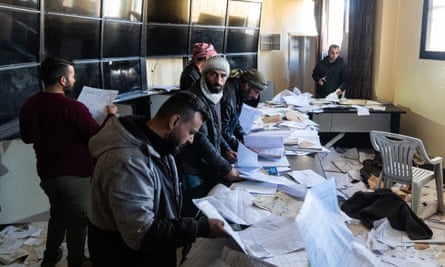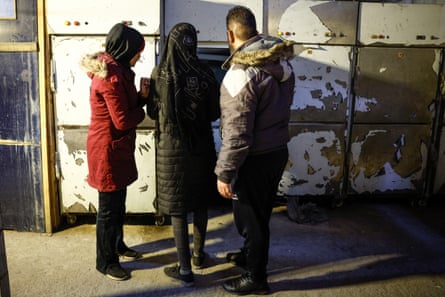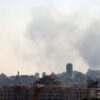The last time Alaa Qasar saw her father, in 2013, he studied her face as if he was trying to memorise it. Moutaz Adnan Qasar had returned to her after his release by Bashar al-Assad’s security forces, who had arrested and questioned him after he had led his family out of the besieged Damascus suburb of Ghouta. Back with his family, he lined up his three children and stared at them hard. The next day he was re-arrested and he was not seen again.
“They told us he would come back to us the next day but he didn’t. They said he was talking to terrorists, but he wasn’t talking to anyone. He would just go to work and then come home,” said Qasar, 29, a secretary in Damascus and the eldest of her siblings.

She is one of the hundreds of thousands of Syrians still searching for their loved ones two weeks after the Assad regime fell and prisons were opened. More than 136,000 Syrians were arrested by the Assad regime after 2011 and held in the many detention centres and prisons where guards attempted to break the will of dissenters through torture and starvation. Most have not been found.
Qasar has spent the last 11 years searching for her father. She spoke to lawyers and security officials but received no information. So-called mediators – middlemen who claimed they could help families find missing loved ones and even secure their release from prison for a fee – dogged her family as they searched. Eventually, she was told her father was being held in Sednaya, known as the “human slaughterhouse”, one of the most infamous of all of Assad’s prisons.
When rebels swept across the country from the end of November, freeing prisoners as they went, Qasar watched in disbelief – beginning to hope as they approached Sednaya, just 12 miles (20km) from Damascus. Then Assad fled and rebels opened the gates of the prison – but her father did not appear.
Qasar did not give up. Rumours circulated of underground cells in Sednaya, of detention centres so secretive that only the country’s leadership knew their location. She visited Sednaya and found no underground cells. She went from prison to prison, looking for people who had not yet been claimed – but her father did not appear.
Soon, prison records were turned into an electronic database of those who were detained. Qasar typed her father’s name in and a match was returned. It said he had been issued a death certificate some years earlier.




“I won’t believe it until I see his body. I’ve heard of people who were issued death certificates but turned out to have been released years before,” Qasar said. “We heard of a widow who remarried and her husband appeared on the day of her wedding.”
To Fadel Abdulghany, the director of the Syrian Network for Human Rights (SNHR), that most of the disappeared were not still in prison was unfortunately not a surprise. Since the Assad regime began cracking down on peaceful revolutionaries in 2011, he had been collecting the names of thousands Syrians who had been arrested and forcibly disappeared.
By comparing them with death certificates issued by the Assad regime, he found that the vast majority of the disappeared had been killed in prison. It was an extrapolation based on the large sample size he had collected, but he took it as a worrying indicator. A later leak from someone working in the Assad regime of a registry including death certificates not issued publicly confirmed his fears.
When rebels began to open up the country’s prisons, SNHR documented the release of 31,000 people – leaving more than 100,000 still missing. He went on TV to announce that people should brace themselves for the possibility that their loved ones would not resurface, something he had not previously said “because I had a moral duty to my people and didn’t want to shock them”.
Qasar was still searching. She saw a post on Telegram that showed a new batch of deceased prisoners had been found and delivered to Mujtahid hospital in Damascus. She went to the hospital on Wednesday and was stopped at the entrance to the morgue by an employee who insisted it had not received any more bodies. Qasar showed the employee the picture and he sighed: “Those are the same bodies, their skin has just started to change with time.”
She insisted on going in to check one more time and was followed by a line of people looking for their family members. One man in line had a piece of paper with 18 names written down, all of them loved ones, none of them checked off.




Qasar opened the door of the morgue. Twelve corpses lay on the ground, loosely covered by white plastic zip bags. A man followed Qasar inside, holding the neck of his sweater over his nose, but quickly fled, chased out by the smell. Qasar remained. She bent over and gently lifted the white plastic that covered each of them, lingering and studying their faces like her father did hers 11 years ago.
She moved to the individual morgue fridges, pulling out people who lay motionless on the refrigerated beds. Some bore obvious marks of torture: flesh missing from their jaws, skin turned black from electrocution, necks distended from hangings. All were emaciated, their ribs protruding dangerously from underneath their skin and their rail-thin arms able to be circled by two fingers. Others looked as if they were sleeping. Qasar paused on one man, his black hair parted down the middle, falling softly over his forehead.
She closed the last drawer. None of them were her father. If she could not identify the face, she was looking for a small tattoo on his wrist, the first initials of his and his wife’s name: AM. Qasar’s father had got the tattoo just before he and her mother got engaged.
The line of people continued their shuffling procession behind Qasar, each one pausing to look at the dead when it was their turn. “It feels like a museum. I started to hope that I wouldn’t find my father between them, I didn’t want to see him like this,” Qasar said.




The Assad regime divided its repression across different branches and facilities, each with its own prisons and detention centre. All came together to form a black box into which people like Qasar’s father disappeared, never to be seen again.
And when the Assad regime and its prison guards fled, they left behind no blueprint to help navigate the dizzying security apparatus they had ruled for 54 years. They instead left it to people like Qasar and the hundreds of thousands of other Syrians searching for their missing loved ones to figure it out on their own.
In their search, Qasar and others were confronted with the horrific tools the Assad regime used to oppress its own people. They had to meticulously comb its torture chambers, looking for any clue that might reveal the fate of the missing. They were forced to gaze into the faces of dozens of tortured people lying in morgues and imagine in excruciating detail the pain that might have been inflicted upon their relatives.
Hamdan Mohammed, 28, a pharmacist in Damascus looking for his uncle Qadior Masas, said: “Of course, I was crying when I was looking at the bodies, but the horror is not this. The horror is if you end up finding them there.”
Outside Mujtahid hospital, Qasar paused to draw up plans to visit another hospital that is said to hold more bodies. Other families milled about at the walls of the complex, where pictures of corpses were posted for people to identify. A man offered for sale a small booklet with verses from the Qur’an meant to be read at funerals.
“I’m the eldest one in the family, so I’m the one that needs to do this,” Qasar said. “I don’t want my mother to see these people. So I’m alone in this search to find our missing.”
This post was originally published on this site be sure to check out more of their content.








